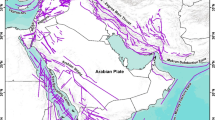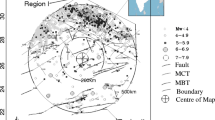Abstract
A probabilistic seismic hazard analysis in terms of peak ground acceleration (PGA) and spectral acceleration (SA) values has been performed for the Egyptian territory. Eighty-eight potential seismic sources (for shallow- and intermediate-depth seismicity) in and around Egypt were identified and characterized based on an updated and unified earthquake catalog spanning the time period from 2200 B.C. until 2013 A.D. A logic-tree approach was followed, after a sensitivity analysis, to consider the epistemic uncertainty in the different input parameters, including the selected ground-motion attenuation models to predict the ground motion for the different tectonic environments. Then the seismic hazard deaggregation results, in terms of distance and magnitude, for the most important cities in Egypt have been computed to help understanding the relative contributions of the different seismic sources. Seismic hazard deaggregation, in particular, was computed for PGA and SA at periods of 0.2, 1.0 and 2.0 s for rock-site conditions, and for 10% probability of exceedance in 50 years. In general, the results at most of the cities indicate that the distance to the seismic sources which mostly contribute to the seismic hazard is mainly controlled by the nearby seismic sources (especially for PGA). However, distant events contribute more to the hazard for larger spectral periods (for 1.0 and 2.0 s). A significant result of this type of work is that seismic hazard deaggregation provides useful data on the distance and magnitude of the contributing seismic sources to the hazard in a certain place, which can be applied to generate scenario earthquakes and select acceleration records for seismic design.










Similar content being viewed by others
References
Abdi, E., Mirzaei, N., & Shabani, E. (2013). Ground-motion scenarios consistent with PSH deaggregation for Tehran, capital city of Iran. Natural Hazards and Earth System Sciences, 13, 679–688.
Abou Elenean, K. M., & Hussein, H. M. (2007). Source mechanism and source parameters of May 28, 1998 earthquake, Egypt. Journal of Seismology, 11, 259–274.
Abrahamson, N. A., & Silva, W. J. (1997). Empirical response spectral attenuation relations for shallow crustal earthquakes. Seismological Research Letters, 68, 94–127.
Ambraseys, N. N., Melville, C. P., & Adams, R. D. (1994). The seismicity of Egypt. Arabia and Red Sea: Cambridge University Press.
Ambraseys, N. N., Simpson, K. A., & Bommer, J. J. (1996). Prediction of horizontal response spectra in Europe. Earthquake Engineering and Structural Dynamics, 25, 371–400.
Badawy, A., & Horváth, F. (1999). Seismicity of the Sinai subplate region: Kinematic implications. Journal of Geodynamics, 27, 451–468.
Barani, S., Spallarossa, D., & Bazzuro, P. (2009). Disaggregation of probabilistic ground-motion hazard in Italy. Bulletin of the Seismological Society of America, 99, 2638–2661.
Bazzurro, P. (1998). Probabilistic seismic demand analysis. Ph.D. thesis, Stanford University.
Bazzurro, P., & Cornell, A. C. (1999). Disaggregation of seismic hazard. Bulletin of the Seismological Society of America, 89, 501–520.
Bernreuter, D. L. (1992). Determining the controlling earthquake from probabilistic hazards for the proposed Appendix B. Lawrence Livermore National Laboratory, Report UCRL-JC-111964, Livermore, EE.UU.
Boomer, J., Douglas, J., Scherbaum, F., Cotton, F., Bungum, H., & Fah, D. (2010). On the selection of ground-motion prediction equations for seismic hazard analysis. Seismological Research Letters, 81, 783–793.
Boore, D. M., & Atkinson, G. M. (2008). Ground-motion prediction equations for the average horizontal component of PGA, PGV, and 5%-damped PSA at spectral periods between 0.01 s and 10.0 s. Earthquake Spectra, 24, 99–138.
Chapman, M. C. (1995). A probabilistic approach to selection of ground motions for engineering design. Bulletin of the Seismological Society of America, 85, 937–942.
Cooke, P. (1979). Statistical inference for bounds of random variables. Biometrika, 66, 367–374.
Cornell, C. A. (1968). Engineering seismic risk analysis. Bulletin of the Seismological Society of America, 58, 1503–1606.
Cotton, F., Scherbaum, F., Bommer, J. J., & Bungum, H. (2006). Criteria for selecting and adjusting ground-motion models for specific target regions: Application to central Europe and rock sites. Journal of Seismology, 10, 137–156.
Deif, A., Abou Elenean, K., El-Hadidy, M., Tealeb, A., & Mohamed, A. (2009). Probabilistic seismic hazard maps for Sinai Peninsula, Egypt. Journal of Geophysical Engineering, 6, 288–297.
Deif, A., Hamed, H., Ibrahim, H. A., Abou Elenean, K., & El-Amin, E. M. (2011). Seismic hazard assessment in Aswan, Egypt. Journal of Geophysical Enginnering, 8, 531–548.
Egyptian National Seismic Network. (ENSN). Bulletins (1998–2010). Earthquakes in and around Egypt. National Research Institute of Astronomy and Geophysics (NRIAG), Cairo, Egypt.
Engdahl, E. R., Van Der Hilstand, R., & Buland, R. (1998). Global teleseismic earthquake relocation with improved travel times and procedures for depth determination. Bulletin of Seismological Society of America, 88, 722–743.
Esteva, L. (1970). Seismic risk and seismic design decisions. In R. J. Hansen (Ed.), Seismic design for nuclear power plants (pp. 142–182). Massachusetts Institute of Technology Press, Cambridge, MA, USA.
Frankel, A. (1995). Mapping seismic hazard in the Central and Eastern United States. Seismological Research Letters, 66, 8–21.
Gardner, J. K., & Knopoff, L. (1974). Is the sequence of earthquakes in Southern California, with aftershocks removed, Poissonian? Bulletin of the Seismological Society of America, 64, 1363–1367.
Gutenberg, B., & Richter, C. F. (1944). Frequency of earthquakes in California. Bulletin of the Seismological Society of America, 34, 185–188.
Harmsen, S., & Frankel, A. (2001). Geographic deaggregation of seismic hazard in the United States. Bulletin of the Seismological Society of America, 91, 13–26.
Harmsen, S., Perkins, D., & Frankel, A. (1999). Deaggregation of probabilistic ground motions in the Central and Eastern United States. Bulletin of the Seismological Society of America, 89, 1–13.
International Seismological Centre. (2011). On-line Bulletin. http://www.isc.ac.uk. International Seismological Centre, Thatcham, United Kingdom.
Kebeasy, R. M. (1990). Seismicity. In R. Said (Ed.), The geology of Egypt (pp. 51–59). Rotterdam: A.A. Balkerma.
Kijko, A., & Singh, M. (2011). Statistical tools for maximum possible earthquake magnitude estimation. Acta Geophysica, 59, 674–700.
Maamoun, M., Allam, A., & Megahed, A. (1984). Seismicity of Egypt. Bulletin of Helwan Institute of Astronomy and Geophysics, 4, 109–160.
McGuire, R. K. (1995). Probabilistic seismic hazard analysis and design earthquakes: Closing the loop. Bulletin of the Seismological Society of America, 85, 1275–1284.
Ordaz, M., Faccioli, E., Martinelli, F., Aguilar, M., Arboleda, J., Meletti, C., et al. (2014). CRISIS 2014: Program for computing seismic hazard. UNAM, Mexico: Institute of Engineering.
Panzera, F., Lombardo, G., & Rigano, R. (2011). Use of different approaches to estimate seismic hazard: the study cases of Catania and Siracusa, Italy. Bollettino di Geofisica Teorica ed Applicata, 52, 687–706.
Pelaéz, J. A., Hamdache, M., & Casado, C. L. (2005). Updating the probabilistic seismic hazard values of Northern Algeria with the 21 May 2003 M 6.8 Algiers earthquake included. Pure and Applied Geophysics, 162, 2163–2177.
Pelaéz, J. A., & López Casado, C. (2002). Seismic hazard estimate at the Iberian Peninsula. Pure and Applied Geophysics, 159, 2699–2713.
Pelaéz, J. A., López Casado, C., & Henares, J. (2002). Deaggregation in magnitude, distance, and azimuth in the south and west of the Iberian Peninsula. Bulletin of the Seismological Society of America, 92, 2177–2185.
Pollastro, R. M. (2003). Total petroleum systems of the Paleozoic and Jurassic, Greater Ghawar Uplift and adjoining provinces of Central Saudi Arabia and Northern Arabian-Persian Gulf. US. Geological Survey Bulletin 2202-H.
Riad, S., & Meyers, H. (1985). Earthquake catalogue for the Middle East countries (1900–1983). National Geophysical Data Centre, World Data Centre A for Solid Earth Geophysics. Rep. SE-40. National Oceanic and Atmospheric Administration (NOAA), US Department of Commerce, Boulder, Colorado, USA.
Riad, S., Taeleb, A. A., El Hadidy, S., Basta, N. Z., Abou Elela, A. M., Mohamed, A. A., et al. (2004). Ancient earthquakes from some Arabic sources and catalogue of Middle East historical earthquakes (pp. 71–91). Paris: EGSMA, NARSS, UNDP, UNESCO.
Robson, D. S., & Whitlock, J. H. (1964). Estimation of a truncation point. Biometrika, 51, 33–39.
Sawires, R., Peláez, J. A., Fat-Helbary, R. E., & Ibrahim, H. A. (2016a). An earthquake catalogue (2200 B.C. to 2013) for seismotectonic and seismic hazard assessment studies in Egypt. In S. D’Amico (Ed.), Earthquakes and their impact on society (pp. 97–136). Berlin: Springer.
Sawires, R., Peláez, J. A., Fat-Helbary, R. E., & Ibrahim, H. A. (2016b). Updated probabilistic seismic hazard values for Egypt. Bulletin of the Seismological Society of America, 106, 1788–1801.
Sawires, R., Peláez, J. A., Fat-Helbary, R. E., Ibrahim, H. A., & García-Hernández, M. T. (2015). An updated seismic source model for Egypt. In A. Moustafa (Ed.), Earthquake engineering—From engineering seismology to optimal seismic design of engineering structures (pp. 1–52). Croatia: InTech.
Sawires, R., Peláez, J. A., Ibrahim, H. A., & Fat-Helbary, R. E. (2016c). Delineation and characterization of a new seismic source model for seismic hazard studies in Egypt. Natural Hazards, 80, 1823–1864.
SHARE-Seismic Hazard Harmonization in Europe. (2013). http://www.share-eu.org/.
Tavakoli, B., & Pezeshk, Sh. (2005). Empirical-stochastic ground-motion prediction for Eastern North America. Bulletin of the Seismological Society of America, 95, 2283–2296.
Tselentis, G. A., & Danciu, L. (2010). Probabilistic seismic hazard assessment in Greece—Part 3: Deaggregation. Natural Hazards and Earth System Sciences, 10, 51–59.
Youngs, R. R., Chiou, S. J., Silva, W. J., & Humphery, J. R. (1997). Strong ground motion attenuation relationships for subduction zone earthquakes. Seismological Research Letters, 68, 58–73.
Zhao, J. X., Zhang, J., Asano, A., Ohno, Y., Oouchi, T., Takahashi, T., et al. (2006). Attenuation relations of strong ground motion in Japan using site classification based on predominant period. Bulletin of the Seismological Society of America, 96, 898–913.
Ziegler, M. A. (2001). Late Permian to Holocene Paleofacies evolution of the Arabian Plate and its hydrocarbon occurrences. GeoArabia, 6, 445–504.
Acknowledgements
This research work was supported by the Egyptian Ministry of Higher Education (Cultural Affairs and Missions Sector), Cairo, Egypt, and the Spanish MINECO CGL2015-65602-R Project. We would like to thank Editor Andrzej Kijko and Reviewer Sebastiano D’Amico for their thoughtful comments.
Author information
Authors and Affiliations
Corresponding author
Rights and permissions
About this article
Cite this article
Sawires, R., Peláez, J.A., Fat-Helbary, R.E. et al. Probabilistic Seismic Hazard Deaggregation for Selected Egyptian Cities. Pure Appl. Geophys. 174, 1581–1600 (2017). https://doi.org/10.1007/s00024-017-1490-5
Received:
Revised:
Accepted:
Published:
Issue Date:
DOI: https://doi.org/10.1007/s00024-017-1490-5




